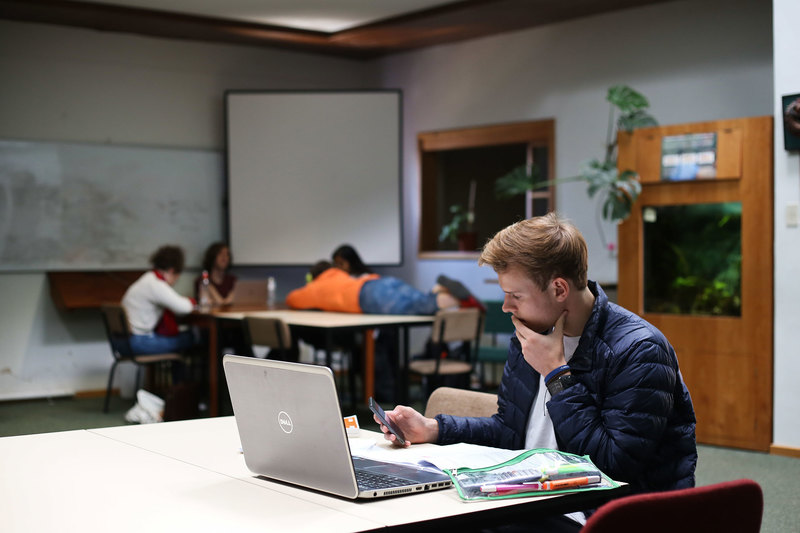Against the ‘new normal’ – reflections on universities after COVID-19
28 September 2022 | Story Lis Lange. Photo Je’nine May. Read time 6 min.
There is a notion that educational technologies are a solution to the issue of access to higher education. Education can help counter inequality but it does not do away with it, says the University of Cape Town’s (UCT) former deputy vice-chancellor for Teaching and Learning, Lis Lange, who is currently associate professor at the university’s Centre for Higher Education Development.
The onset of the global pandemic of Covid-19 caused radical and dramatic unplanned shifts in higher education in South Africa and the world.
So urgent and desperate was the need to implement changes in the face of Covid-19 that there was indeed little space or time for ideological and political contestation, weighing up operational options, debating the pros and cons of systems before implementation.
The realisation soon dawned on institutions that the pandemic was not a temporary glitch in ongoing activities. It was clear early on that it was a phenomenon of unpredictable duration with wide and deep consequences.
Covid-19 had the potential to drastically collapse the educational trajectories of many of the over a million higher education students in SA. It was dramatically evident that ready or not, institutions had no alternative but to embark on a drastic intervention. So emergency remote teaching (ERT) was implemented.
The will to avoid an educational disintegration on a massive scale shocked university leadership, IT companies, the edutech industry, global consultancy firms and almost every other player in the higher education field into immediate action.
Teaching and learning moved online in an instant. The physical campus drained of students and teachers and the university became a virtual school, made up of individual students and teachers working in isolation behind a screen at home. The university timetable, an instrument that organised lectures, physical spaces and the daily movement of thousands of people on campus, fell by the wayside.
New governance teams and structures sprung into being. New technological platforms were created. Particularly at undergraduate level, a variety of discussion and planning fora, training and monitoring systems were put in place. Universities and the state mobilised resources in an attempt to support students. Almost overnight universities across South Africa moved into a new mode of delivering teaching and learning. It was an unimaginable, comprehensive shift into a new way of being.
As the pandemic rooted itself firmly into being, a “new normal” was left in its wake.
Somehow, a sense developed that largely thanks to technology, we would wake from the Covid nightmare in a better, kinder, more equal world where education can reach everyone in new and better ways and that we would never return to the pre-Covid, old ways of doing things.
But there is a nagging question to be posed: what are the meaning and implications of the ‘new normal’, not just for teaching and learning but for society more broadly?
Particularly, as the pandemic trajectory has evolved and we are returning to campuses across our country, we need to reassess whether the ‘new normal’ is to stay, to be reversed, or altered in some way. It is profoundly important for us to engage critically with the ‘new normal, its meaning and its implications.
Three factors to be interrogated, amongst others, come to mind.
Technology focus
There is a notion that educational technologies are a solution to the issue of access to higher education.
The reality has proved this notion to be false. Education can help counter inequality but it does not do away with it. Access to higher education is definitely a critical issue. But the notion that virtual universities can make possible seemingly endless growing enrolments of students who will now learn successfully online regardless of their circumstances is false. The idea of a ‘new normal’ of expanded access to education through technology does not take into account that the limit to the new normal is the old normal: a model of economic development that increases inequality as part of its DNA. None of the current curricular fads being proposed for the future of higher education, whether it is competency-based education, or teaching computer coding, will solve the problem. I agree with Prof Bawa, the CEO of USAf, who last year said that “higher education is not a floating system that could afford to be blind to unequal realities in communities, as it is embedded in social systems”. The fact is that the reality of poverty and inequality will continue to hamper student success.
There is also a notion that the “platformisation” of higher education could solve the issue of student success.
Everyone knows that higher education policies are being influenced by the edutech industry to whom education is a market opportunity. A constant message being broadcast is that technology will solve the problem of student success. The argument is that the ‘new normal’ of a virtual campus is better, more flexible, easier, more effective. Some authors call this the “platformisation” of education systems, that is the use of digital learning platforms to decentralise the delivery of education.
It is possible to imagine a future of the progressive privatisation of education in which, through the use of platforms, education slowly becomes a private, individual matter away from institutional practices and the collective experiences of cohorts of students. I would argue this constitutes the undoing of education as both socialisation into a community and a social responsibility. Moving ahead with the “platformisation” of HE, as a way of balancing the books, or to be at the “cutting edge” of the new fashion, will make universities complicit in the reproduction of some of the most dangerous features of the 21st century global culture: isolation and individualism, not to mention the terrible mental health consequences.
Data dilemma
Our experience during Covid-19 and reports worldwide taught us that there are serious shortcomings related to the “new normal” including the loss of deep learning online; students’ disengagement and a rise in academic dishonesty. In addition, we need to be most alert to the link between social media/digital platforms and the serious and constantly increasing mental health pandemic within the student body. This needs serious, urgent consideration.
There is a third notion that the centrality of data will automatically improve educational offerings and decisions.
Data analytics in education is a fantastic tool to follow students’ trajectories in their courses to alert them to the risk of failure, to identify and diagnose problems and develop appropriate individual or collective interventions. All universities should use them. We have seen a boom in institutional capabilities and use of data analytics.
There is, however, a significant risk embedded in the unchecked use of data analytics.
“The sentiments and behaviours of learners are thus ‘nudged’ in predictable ways, grounded in theoretical frameworks from psychology that assume irrational and unconscious decision-making. As behavioural science has merged with data science, new forms of ‘persuasive computing’ and ‘hypernudge’ techniques have become possible (Yeung 2017). Consequently, human learning appears susceptible to heightened forms of governance as digital environments become ever more connected, and education becomes subsumed into broader political agendas of behavioural governance.”
This is enormously important educationally, politically and morally. First, because education needs to remain a conscious process that is not determined only by the need to gain, or interest in gaining, knowledge or skills but that is guided by the teacher to both predictable and unpredictable outcomes which are not only individual but social. Secondly, much-desired critical thinking does not emerge as a product of machine nagging but through human encounters in argument.
It is clear from these three points alone that there is much to consider. We need to be awake to the many dangers, moral contradictions and social pitfalls that the ‘new normal’ brings about.
Reflection and improvement
It is a wise step to use the rapid change that took place in higher education during Covid-19 as a stepping stone or catalyst for significant, positive improvement of the educational offering in South Africa. No doubt about that.
Universities have an obligation to investigate and interrogate what the ‘new normal’ means, for whom it has what impact, and what its purpose is. Is it good? Is it fair? Is it right? And the million dollar question, what is ‘normal’ and who decides so?
We must interrogate the meaning and impact of the ‘new normal’ on education at large, on students and on teachers as varied and complex as they are. It is imperative that we do not automatically fall into and accept the ‘new normal’ because technology makes it possible.
As Bernard Stiegler (2019) said: “ technology is a pharmakon (a mixture of remedy and poison) and this requires from us great care, awareness and responsibility in its utilisation.”
Technological acceleration in the last century has transformed the planet, our societies and ourselves, but for the large majority of the population, it has failed to transform our understanding of the things it creates. We must snap out of blind optimism when dealing with new technology.
As Briddle (2019) puts it, “technology does not just increase our abilities, but it shapes and directs them. If we do not understand how complex technology functions, how systems of technologies interconnect and how systems of systems interact we are powerless within them.” But, he continues, “understanding is not limited to how things work, it has to extend to how they came to be. What is required is literacy in systems, something very different from learning to code.”
This will help us overcome the idea that computation provides solutions and can explain the world. If philosophy is the fraction of human thought dealing with what cannot be explained by the sciences, Briddle says, systemic literacy is the thinking that deals with a world that is not computable. It is this literacy that allows us to critique and respond to critique.
Universities have an enormous responsibility to touch and shape students’ lives, to become citizens capable of engaging and transforming the world around them. This is the purpose at the heart of higher education.
How we shape the educational landscape in the post-Covid era is a matter of critical importance. We should wake up to all the possibilities, all the pitfalls, all the consequences.
By doing so we can create that which goes beyond the ‘new normal’ and deliver education and a society that is based on fairness and is truly transformative as well as sustainable.
Lis Lange is Associate Professor at the Centre for Higher Education Development at UCT. She was Deputy Vice-Chancellor Teaching and Learning at the University of Cape Town and Deputy Vice-Chancellor Academic at the University of the Free State.










